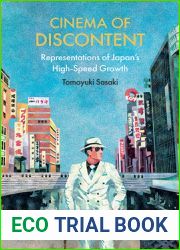
BOOKS - Cinema of Discontent (Suny Series, Horizons of Cinema)

Cinema of Discontent (Suny Series, Horizons of Cinema)
Author: Tomoyuki Sasaki
Year: December 1, 2022
Format: PDF
File size: PDF 8.2 MB
Language: English

Year: December 1, 2022
Format: PDF
File size: PDF 8.2 MB
Language: English

Cinema of Discontent: Suny Series, Horizons of Cinema The book "Cinema of Discontent" offers a unique perspective on the history of post-war Japan, challenging the traditional narrative of the country's rapid economic growth and instead highlighting the tensions and contradictions that emerged during this period. Through an analysis of popular films from the era of high-speed growth, the author reveals the underlying issues that were present beneath the surface of Japan's success story. These films, directed by prominent directors such as Kawashima Yuzo, Masumura Yasuzo, Inoue Akira, Ezaki Mio, and Kumashiro Tatsumi, attracted broad audiences but have been largely overlooked by scholars until now. The book sets out to demonstrate how these films address the problems inherent in Japan's post-war capitalism, including uneven development, increasing corporate control over individuals, precarious and contingent work, and the militarized nature of peace and prosperity. By contextualizing these films within the political, economic, intellectual, and cultural discourses of the time, the author provides a nuanced understanding of the complexities of Japan's modernization process. The book begins by examining the impact of the U. S. -Japan alliance on Japanese cinema, particularly in the 1950s and 1960s, when the country was undergoing rapid industrialization and modernization. The author argues that this period saw the emergence of a new kind of cinema that reflected the tensions and contradictions of the time, rather than simply celebrating the success of the nation.
Cinema of Discontent: Suny Series, Horizons of Cinema Книга «Кино недовольства» предлагает уникальный взгляд на историю послевоенной Японии, бросая вызов традиционному повествованию о быстром экономическом росте страны и вместо этого подчеркивая напряженность и противоречия, возникшие в этот период. Анализируя популярные фильмы эпохи быстрого роста, автор раскрывает основные проблемы, которые присутствовали под поверхностью истории успеха Японии. Эти фильмы, снятые такими выдающимися режиссёрами, как Кавасима Юдзо, Масумура Ясудзо, Иноуэ Акира, Эдзаки Мио и Кумасиро Тацуми, привлекли широкую аудиторию, но до сих пор в значительной степени игнорировались учёными. Книга призвана продемонстрировать, как эти фильмы решают проблемы, присущие послевоенному капитализму Японии, включая неравномерное развитие, усиление корпоративного контроля над отдельными лицами, ненадежный и условный труд, а также милитаризованный характер мира и процветания. Контекстуализируя эти фильмы в рамках политических, экономических, интеллектуальных и культурных дискурсов того времени, автор дает тонкое понимание сложностей процесса модернизации Японии. Книга начинается с изучения влияния союза США и Япона на японское кино, особенно в 1950-х и 1960-х годах, когда страна переживала быструю индустриализацию и модернизацию. Автор утверждает, что в этот период появился новый вид кино, который отражал напряжённость и противоречия того времени, а не просто праздновал успех нации.
Cinema of Discontent : Suny Series, Horizons of Cinema livre Cinéma du mécontentement offre une vision unique de l'histoire du Japon d'après-guerre, remettant en question le récit traditionnel de la croissance économique rapide du pays et soulignant plutôt les tensions et les contradictions qui sont apparues au cours de cette période. En analysant les films populaires de l'ère de la croissance rapide, l'auteur révèle les principaux problèmes qui étaient présents sous la surface de l'histoire du succès du Japon. Ces films, réalisés par d'éminents réalisateurs comme Kawashima Yuzo, Masumura Yasuzo, Inoue Akira, Ezaki Mio et Kumashiro Tatsumi, ont attiré un large public, mais ont été jusqu'à présent largement ignorés par les scientifiques. livre vise à montrer comment ces films résolvent les problèmes inhérents au capitalisme japonais d'après-guerre, y compris le développement inégal, le renforcement du contrôle des entreprises sur les individus, le travail précaire et conditionnel, ainsi que le caractère militarisé de la paix et de la prospérité. En contextualisant ces films dans les discours politiques, économiques, intellectuels et culturels de l'époque, l'auteur donne une compréhension subtile des difficultés du processus de modernisation du Japon. livre commence par étudier l'impact de l'union des États-Unis et du Yapon sur le cinéma japonais, en particulier dans les années 1950 et 1960, lorsque le pays a connu une industrialisation et une modernisation rapides. L'auteur affirme qu'un nouveau type de film est apparu au cours de cette période, qui reflétait les tensions et les contradictions de l'époque, plutôt que de célébrer le succès de la nation.
Cinema of Discontent: Suny Series, Horizons of Cinema libro «cine del descontento» ofrece una visión única de la historia del Japón de la posguerra, desafiando la narrativa tradicional del rápido crecimiento económico del país y, en cambio, destacando las tensiones y contradicciones surgidas durante este período. Analizando películas populares de una época de rápido crecimiento, el autor revela los principales problemas que estaban presentes bajo la superficie de la historia de éxito de Japón. Estas películas, realizadas por destacados directores como Kawashima Yuzō, Masumura Yasuzo, Inoue Akira, Edzaki Mio y Kumashiro Tatsumi, atrajeron a un público amplio, pero hasta ahora eran ignoradas en gran medida por los científicos. libro pretende demostrar cómo estas películas abordan los problemas inherentes al capitalismo de la posguerra de Japón, incluyendo el desarrollo desigual, el aumento del control corporativo sobre los individuos, el trabajo poco fiable y condicional, y el carácter militarizado de la paz y la prosperidad. Al contextualizar estas películas en el marco de los discursos políticos, económicos, intelectuales y culturales de la época, el autor da una sutil comprensión de las complejidades del proceso de modernización de Japón. libro comienza estudiando la influencia de la unión entre Estados Unidos y Yapón en el cine japonés, especialmente en las décadas de 1950 y 1960, cuando el país experimentó una rápida industrialización y modernización. autor sostiene que en este periodo surgió un nuevo tipo de cine que reflejaba las tensiones y contradicciones de la época, en lugar de simplemente celebrar el éxito de la nación.
Cinema of Discontent: Suny Series, Horizontes of Cinema O livro «Cinema do descontentamento» oferece uma visão única da história do Japão pós-guerra, desafiando a narrativa tradicional sobre o rápido crescimento econômico do país e enfatizando as tensões e contradições que surgiram durante este período. Analisando filmes populares da era do crescimento rápido, o autor revela os principais problemas que estavam presentes sob a superfície da história de sucesso do Japão. Esses filmes, realizados por grandes realizadores como Kawashima Yuzo, Masumura Yasuzo, Inoue Akira, Edzaki Mio e Kumasiro Tatsumi, atraíram uma grande audiência, mas até agora foram ignorados pelos cientistas. O livro tem como objetivo demonstrar como estes filmes resolvem os problemas inerentes ao capitalismo japonês no pós-guerra, incluindo o desenvolvimento desigual, o aumento do controle corporativo sobre os indivíduos, o trabalho precário e condicionado e o caráter militarizado da paz e prosperidade. Ao contextualizar esses filmes como parte dos discursos políticos, econômicos, intelectuais e culturais da época, o autor oferece um entendimento sutil das complexidades do processo de modernização do Japão. O livro começa com um estudo da influência da aliança entre os EUA e o Japão no cinema japonês, especialmente nos anos 1950 e 1960, quando o país vivia uma rápida industrialização e modernização. O autor afirma que neste período surgiu um novo tipo de filme que refletiu as tensões e contradições da época, em vez de apenas celebrar o sucesso da nação.
Cinema of Discontent: Suny Series, Orizzonti of Cinema Il libro «Il cinema del malcontento» offre una visione unica della storia del Giappone del dopoguerra, sfidando la narrazione tradizionale della rapida crescita economica del Paese e sottolineando invece le tensioni e le contraddizioni che si sono verificate in questo periodo. Analizzando i film più popolari di un'epoca di rapida crescita, l'autore rivela i principali problemi presenti sotto la superficie della storia del successo giapponese. Questi film, realizzati da grandi registi come Kawashima Yuso, Masumura Yasudzo, Inoe Akira, Edzaki Mio e Kumasiro Tatsumi, hanno attirato un vasto pubblico, ma finora sono stati ampiamente ignorati dagli scienziati. Il libro ha lo scopo di dimostrare come questi film affrontano le sfide inerenti al capitalismo giapponese del dopoguerra, tra cui lo sviluppo ineguagliabile, il rafforzamento del controllo aziendale sui singoli individui, il lavoro inaffidabile e condizionato e il carattere militarizzato della pace e della prosperità. Contestualizzando questi film nell'ambito dei discorsi politici, economici, intellettuali e culturali dell'epoca, l'autore offre una delicata comprensione delle complessità del processo di modernizzazione del Giappone. Il libro inizia studiando l'impatto dell'unione USA-Japon sul cinema giapponese, soprattutto negli annì 50 è 60, quando il paese stava vivendo una rapida industrializzazione e modernizzazione. L'autore sostiene che in questo periodo c'è stato un nuovo tipo di film che rifletteva le tensioni e le contraddizioni dell'epoca, non solo celebrando il successo della nazione.
Cinema of Discontent: Suny Series, Horizonte des Kinos Das Buch „Kino der Unzufriedenheit“ bietet einen einzigartigen Einblick in die Geschichte des Nachkriegsjapans, indem es die traditionelle Erzählung des schnellen Wirtschaftswachstums des Landes in Frage stellt und stattdessen die Spannungen und Widersprüche hervorhebt, die in dieser Zeit entstanden sind. Bei der Analyse populärer Filme aus der Zeit des schnellen Wachstums deckt der Autor die Hauptprobleme auf, die unter der Oberfläche der japanischen Erfolgsgeschichte vorhanden waren. Diese Filme, die von so herausragenden Regisseuren wie Kawashima Yuzo, Masumura Yasuzo, Inoue Akira, Ezzaki Myo und Kumashiro Tatsumi gedreht wurden, zogen ein breites Publikum an, wurden aber von Wissenschaftlern bisher weitgehend ignoriert. Das Buch soll zeigen, wie diese Filme die dem japanischen Nachkriegskapitalismus innewohnenden Probleme lösen, einschließlich der ungleichmäßigen Entwicklung, der zunehmenden Kontrolle von Unternehmen über Einzelpersonen, prekärer und konventioneller Arbeit sowie des militarisierten Charakters von Frieden und Wohlstand. Durch die Kontextualisierung dieser Filme im Rahmen der politischen, wirtschaftlichen, intellektuellen und kulturellen Diskurse der Zeit gibt der Autor einen subtilen Einblick in die Komplexität des japanischen Modernisierungsprozesses. Das Buch beginnt mit einer Untersuchung der Auswirkungen der US-Yapon-Allianz auf das japanische Kino, insbesondere in den 1950er und 1960er Jahren, als das Land eine schnelle Industrialisierung und Modernisierung erlebte. Der Autor behauptet, dass in dieser Zeit eine neue Art von Kino entstand, die die Spannungen und Widersprüche der Zeit widerspiegelte und nicht nur den Erfolg der Nation feierte.
Cinema of Discovent: Suny Series, Horizons of Cinema הספר ”קולנוע של חוסר שביעות רצון” מציע נקודת מבט ייחודית על ההיסטוריה של יפן שלאחר המלחמה, קורא תיגר על הנרטיב המסורתי של הצמיחה הכלכלית המהירה של המדינה ובמקום זאת מדגיש את המתחים והסתירות שקמו בתקופה זו. בניתוח סרטים פופולריים מתקופת הצמיחה המהירה, חושף הסופר את הבעיות העיקריות שנכחו מתחת לפני השטח של סיפור ההצלחה של יפן. סרטים אלה, שבוימו על ידי במאים בולטים כגון קוואשימה יוזו, מסומורה יאסוזו, אינואה אקירה, אזאקי מיו וקומשירו טאטסומי, משכו קהל רחב, אך עד כה התעלמו במידה רבה מהמדענים. הספר שואף להדגים כיצד סרטים אלה מתייחסים לסוגיות הטמונות בקפיטליזם של יפן לאחר המלחמה, כולל פיתוח לא אחיד, שליטה תאגידית מוגברת על יחידים, כוח עבודה מסוכן ונציגות, והאופי הצבאי של שלום ושגשוג. על ידי חיבור סרטים אלה בתוך השיח הפוליטי, הכלכלי, האינטלקטואלי והתרבותי של אותה תקופה, המחבר מספק הבנה מגוונת של המורכבות של תהליך המודרניזציה של יפן. הספר מתחיל בבחינת השפעתה של ברית ארצות הברית-ג 'אפון על הקולנוע היפני, במיוחד בשנות החמישים והשישים, כאשר המדינה עברה תיעוש מהיר ומודרניזציה. המחבר טוען שבמהלך תקופה זו הופיע סוג חדש של קולנוע, ששיקף את המתח והסתירות של אותה תקופה, ולא רק חגג את הצלחת האומה.''
Hoşnutsuzluk neması: Suny Serisi, nemanın Ufukları "Hoşnutsuzluk neması" kitabı, savaş sonrası Japonya'nın tarihine benzersiz bir bakış açısı sunarak, ülkenin hızlı ekonomik büyümesinin geleneksel anlatısına meydan okuyor ve bunun yerine bu dönemde ortaya çıkan gerilimleri ve çelişkileri vurguluyor. Hızlı büyüme döneminin popüler filmlerini analiz eden yazar, Japonya'nın başarı öyküsünün yüzeyinde mevcut olan temel sorunları ortaya koyuyor. Kawashima Yuzo, Masumura Yasuzo, Inoue Akira, Ezaki Mio ve Kumashiro Tatsumi gibi seçkin yönetmenler tarafından yönetilen bu filmler geniş bir izleyici kitlesine ulaştı, ancak şimdiye kadar bilim adamları tarafından büyük ölçüde göz ardı edildi. Kitap, bu filmlerin Japonya'nın savaş sonrası kapitalizminin doğasında var olan eşitsiz gelişme, bireyler üzerinde artan kurumsal kontrol, güvencesiz ve koşullu emek ve barış ve refahın militarize doğası gibi konuları nasıl ele aldığını göstermeyi amaçlıyor. Yazar, bu filmleri zamanın politik, ekonomik, entelektüel ve kültürel söylemleri içinde bağlamsallaştırarak, Japonya'nın modernleşme sürecinin karmaşıklıklarına dair nüanslı bir anlayış sunuyor. Kitap, ABD-Japonya ittifakının Japon sineması üzerindeki etkisini, özellikle ülkenin hızlı sanayileşme ve modernleşme sürecine girdiği 1950'lerde ve 1960'larda inceleyerek başlıyor. Yazar, bu dönemde, o zamanın gerilimini ve çelişkilerini yansıtan ve sadece ulusun başarısını kutlamayan yeni bir sinema türünün ortaya çıktığını iddia ediyor.
سينما السخط: سلسلة صني، آفاق السينما يقدم كتاب «سينما السخط» منظورًا فريدًا لتاريخ اليابان ما بعد الحرب، متحديًا السرد التقليدي للنمو الاقتصادي السريع للبلاد وبدلاً من ذلك سلط الضوء على التوترات والتناقضات التي نشأت خلال هذه الفترة. عند تحليل الأفلام الشعبية لعصر النمو السريع، يكشف المؤلف عن المشاكل الرئيسية التي كانت موجودة تحت سطح قصة نجاح اليابان. اجتذبت هذه الأفلام، التي أخرجها مخرجون بارزون مثل كاواشيما يوزو وماسومورا ياسوزو وإينوي أكيرا وإيزاكي ميو وكوماشيرو تاتسومي، جمهورًا واسعًا، لكن العلماء تجاهلوها إلى حد كبير حتى الآن. يهدف الكتاب إلى توضيح كيفية معالجة هذه الأفلام للقضايا المتأصلة في رأسمالية اليابان بعد الحرب، بما في ذلك التنمية غير المتكافئة، وزيادة سيطرة الشركات على الأفراد، والعمل غير المستقر والطوارئ، والطبيعة العسكرية للسلام والازدهار. من خلال وضع هذه الأفلام في سياق الخطابات السياسية والاقتصادية والفكرية والثقافية في ذلك الوقت، يقدم المؤلف فهمًا دقيقًا لتعقيدات عملية التحديث في اليابان. يبدأ الكتاب بفحص تأثير التحالف بين الولايات المتحدة واليابون على السينما اليابانية، لا سيما في الخمسينيات والستينيات من القرن الماضي، عندما كانت البلاد تخضع للتصنيع والتحديث السريع. يدعي المؤلف أنه خلال هذه الفترة ظهر نوع جديد من السينما، مما يعكس التوتر والتناقضات في ذلك الوقت، ولم يحتفل فقط بنجاح الأمة.
불만의 영화: Suny Series, Horizons of Cinema "이 책은 전후 일본의 역사에 대한 독특한 관점을 제공하여 국가의 빠른 경제 성장에 대한 전통적인 이야기에 도전하고 대신 긴장과 모순을 강조합니다. 이 기간 동안 일어났다. 빠른 성장 시대의 인기 영화를 분석 한 결과, 저자는 일본의 성공 사례 아래에 존재했던 주요 문제를 밝힙니다. 가와시마 유조, 마수 무라 야스 조, 이노우에 아키라, 에자키 미오, 쿠마시로 타츠미와 같은 뛰어난 감독들이 감독 한이 영화는 많은 관객을 끌어 들였지만 지금까지 과학자들은 크게 무시했다. 이 책은 이러한 영화가 고르지 않은 개발, 개인에 대한 기업 통제 강화, 불안정하고 우발적 인 노동, 평화와 번영의 군사화 된 본질 등 일본의 전후 자본주의에 내재 된 문제를 어떻게 다루는 지 보여줍니다. 저자는 당시의 정치, 경제, 지적 및 문화 담론 내에서 이러한 영화를 맥락화함으로써 일본의 현대화 과정의 복잡성에 대한 미묘한 이해를 제공합니다. 이 책은 미국이 급속한 산업화와 현대화를 겪고있는 1950 년대와 1960 년대에 일본 영화에 대한 미국-일본 동맹의 영향을 조사하는 것으로 시작됩니다. 저자는이시기에 새로운 유형의 영화관이 등장하여 당시의 긴장과 모순을 반영했으며 국가의 성공을 축하하는 것이 아니라고 주장했다.
Discontent Cinema:Suny Series,Cinema Horizons書《不滿的電影院》提供了戰後日本歷史的獨特視角,挑戰了有關該國快速經濟增長的傳統敘述,而是強調了在此期間出現的緊張和矛盾。通過分析快速增長時代的流行電影,作者揭示了日本成功故事表面下存在的主要問題。這些由Kawashima Yuzo,Masumura Yasuzo,Inoue Akira,Edzaki Mio和Kumashiro Tatsumi等著名導演制作的電影吸引了廣泛的觀眾,但到目前為止,學者們在很大程度上被忽略了。該書旨在展示這些電影如何解決日本戰後資本主義固有的問題,包括發展不平衡,企業對個人的控制力增強,不可靠和有條件的勞動以及和平與繁榮的軍事化性質。通過在當時的政治,經濟,知識和文化話語中對這些電影進行上下文化,作者對日本現代化過程的復雜性有了深入的了解。該書首先研究了美國和日本同盟對日本電影的影響,尤其是在1950代和1960代,當時該國經歷了快速的工業化和現代化。作者認為,在此期間出現了一種新型的電影,反映了當時的緊張和矛盾,而不僅僅是慶祝國家的成功。

















































